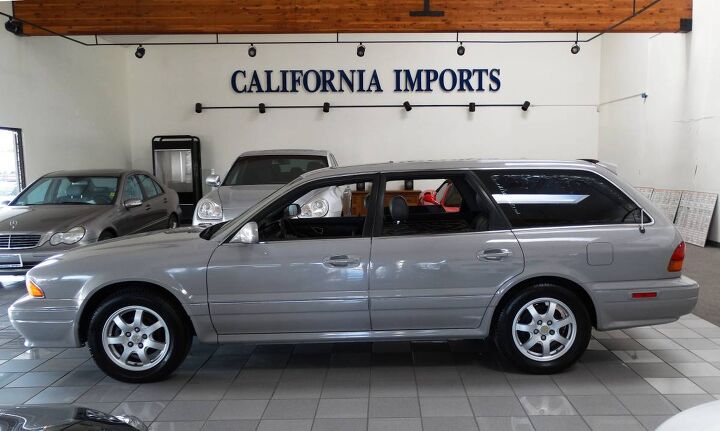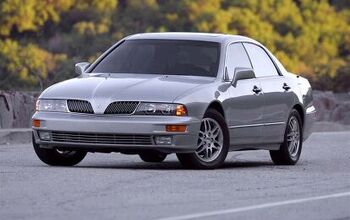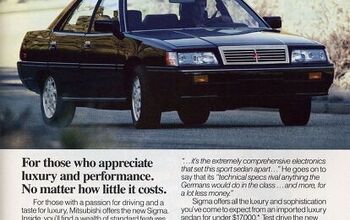Rare Rides: The Luxurious 1993 Mitsubishi Diamante Wagon

We featured the predecessor to Mitsubishi’s American flagship last year — a little Sigma sedan that happened to one of the cheapest Rare Rides ever shown. Today we take a look at the car that came after Sigma: the Diamante.
And it’s the rare wagon version.
Overlapping the end of the Sigma’s life were two distinct models serving as its replacement. On the lower end was the new Galant, which was roughly the same size as the Sigma. The new flagship for Mitsubishi in North America was the more expensive and luxurious Diamante, which was quite a bit larger than the car it replaced.
Mitsubishi needed to step up its offerings abroad after it being surprised by the introduction of the Acura Legend in 1986. The brand had no global car to compete with the Legend, nor anything from the upcoming Lexus and Infiniti brands. Enter Diamante.
There were three body styles, two of which were sold in North America. The most familiar version is the sporty frameless-window sedan (not a true hardtop), which was built in Japan. There was also a more traditional sedan with three windows on each side, a taller roof, and slightly altered front and rear clips. That version was for Europe and the Australian market. Australians called it Magna, and built it domestically. The Magna was used as basis for the North American Diamante wagon, which was designed and built by Mitsubishi of Australia.
The wagon followed the sedan version to North America a bit late. Sedans went on sale for the 1990 model year, but wagons didn’t show up until 1993. While the Japanese market Diamante had available all-wheel drive, all-wheel steering, world-first adaptive cruise control, and various engines and trims, North America received much more straightforward offerings.
There were two trims: base (later ES) or LS, and power was always to the front wheels via an automatic transmission. Base models had a standard 3.0-liter V6 that produced 175 horsepower, while upmarket LS versions had a dual-cam version of the same engine for 202 horses. Base models weren’t shy on equipment, but LS was required if buyers wanted alloy wheels, leather, or a sunroof.
A refresh took place a year after the wagons arrived, with new rear lamps on the sedan, satellite audio controls on the wheel, and a passenger airbag. Unfortunately for Mitsu, the refresh didn’t help move the Diamante. The rather expensive sedan and wagon were off the radar of most buyers. The wagon was dropped after 1995, as did all consumer sales. For ’96, the sedan was still available, though only to fleet customers. The relative product flop didn’t put Mitsubishi off, though, as a new Diamante arrived for 1997. Not that the second album went particularly well, either.
Today’s Diamante wagon is a 1993 example, and with all its equipment and leather trim is definitely an LS. With 134,000 miles, it looks nearly pristine and asks $2,995. It’s located in Orange County, which is slightly south of Downtown California.
H/t to commenter ciscokidinsf, who put today’s Rare Ride on Twitter.
[Images: seller]

Interested in lots of cars and their various historical contexts. Started writing articles for TTAC in late 2016, when my first posts were QOTDs. From there I started a few new series like Rare Rides, Buy/Drive/Burn, Abandoned History, and most recently Rare Rides Icons. Operating from a home base in Cincinnati, Ohio, a relative auto journalist dead zone. Many of my articles are prompted by something I'll see on social media that sparks my interest and causes me to research. Finding articles and information from the early days of the internet and beyond that covers the little details lost to time: trim packages, color and wheel choices, interior fabrics. Beyond those, I'm fascinated by automotive industry experiments, both failures and successes. Lately I've taken an interest in AI, and generating "what if" type images for car models long dead. Reincarnating a modern Toyota Paseo, Lincoln Mark IX, or Isuzu Trooper through a text prompt is fun. Fun to post them on Twitter too, and watch people overreact. To that end, the social media I use most is Twitter, @CoreyLewis86. I also contribute pieces for Forbes Wheels and Forbes Home.
More by Corey Lewis
Latest Car Reviews
Read moreLatest Product Reviews
Read moreRecent Comments
- Lorenzo This car would have sold better if there was a kit to put fiberglass toast slices on the roof.
- Lorenzo The Malibu is close to what the 1955 Bel Air was, but 6 inches shorter in height, and 3 inches shorter in wheelbase, the former making it much more difficult to get into or out of. Grandma has to sit in front (groan) and she'll still have trouble getting in and out.The '55s had long options lists, but didn't include a 91 cubic inch four with a turbo, or a continuously variable transmission. Metal and decent fabric were replaced by cheap plastic too. The 1955 price was $1765 base, or $20,600 adjusted for inflation, but could be optioned up to $3,000 +/-, or $36,000, so in the same ballpark.The fuel economy, handling, and reliability are improved, but that's about it. Other than the fact that it means one fewer sedan available, there's no reason to be sorry it's being discontinued. Put the 1955 body on it and it'll sell like hotcakes, though.
- Calrson Fan We are already seeing multiple manufacturers steering away from EVs to Hybrids & PHEVs. Suspect the market will follow. Battery tech isn't anywhere close to where it needs to be for EV's to replace ICE's. Neither is the electrical grid or charging infrastructure. PHEV's still have the drawback that if you can't charge at home your not a potential customer. I've heard stories of people with Volts that never charge them but that's a unique kind of stupidity. If you can't or don't want to charge your PHEV then just get a hybrid.
- AZFelix The last time I missed the Malibu was when one swerved into my lane and I had to brake hard to avoid a collision. 1 out of 5⭐️. Do not recommend.
- 2ACL I won't miss it; it was decent at launch, but in addition to the bad packaging, GM did little to keep it relevant in the segment. I'd prefer that another domestic automaker doesn't just give up on the mainstream sedan, but unlike some of Ford's swan songs, the Malibu made an indifferent case for why they should live.







































Comments
Join the conversation
Beautiful car. I always liked them because of design being more elegant than Toyota/Honda/Nissan/Mazda. Used ones were pretty cheap in Germany compared with German cars. Still do not understand why they were not popular in US. It's the car made for American tastes.
What a nice car and what a shock at how far Mitsubishi has fallen. Now they build a cheap rollerskate and a bunch of bland me too suv's that aren't compelling.